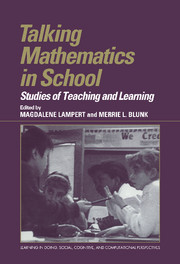10 - Closing Reflections on Mathematical Talk and Mathematics Teaching
Published online by Cambridge University Press: 04 August 2010
Summary
The reform movements in the field of mathematics education are ones that, to those outside the discipline, seem to cut to the core of how mathematics is taught in classrooms. As an educator who studies how children learn in classrooms and also works with preservice and inservice teachers, I have experienced the impact of new math standards for teaching and evaluation. Teachers with whom I conduct classroom research are now beginning to take seriously the mandate that children need to communicate mathematically if they are to participate fully in mathematics learning. Magdalene Lampert articulates succinctly the pedagogical belief that students must be able to participate in authentic mathematics discourses if they are to learn to reason mathematically. In her words (this volume, p. 10), “If they [students] are to conjecture and connect, they will need to communicate.” The published mathematics education standards, and their use among preservice and inservice teachers, has begun to result in changes evident to those of us working directly in classrooms. Even children in kindergarten classrooms are being asked to articulate their mathematical reasonings. Moreover, mathematical discussions are being used as ways to scaffold children's reasonings. The role of communication is being turned on its head in some reform classrooms. It is being used as a critical tool in the construction of knowledge, not simply an articulation of what is assumed to be already “inside” the learner's head.
- Type
- Chapter
- Information
- Talking Mathematics in SchoolStudies of Teaching and Learning, pp. 241 - 252Publisher: Cambridge University PressPrint publication year: 1998
- 2
- Cited by

